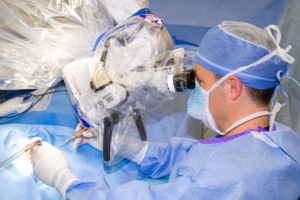 After a child or adult is confirmed as a viable candidate, he or she will have surgery to implant the receiver and electrode array, which is done under general anesthesia on an outpatient basis, and typically takes between two and four hours.
After a child or adult is confirmed as a viable candidate, he or she will have surgery to implant the receiver and electrode array, which is done under general anesthesia on an outpatient basis, and typically takes between two and four hours.
THE SURGICAL STEPS
To begin, the Implant Surgeon uses specialized equipment to create a pocket in the skull behind the affected ear. If required, a small area of hair may be shaved along the incision line, but attempts are always made to keep the shaved area to a minimum.
After the receiver is placed, the surgeon uses a surgical microscope to access the cochlea to connect the electrode array that channels the electric signals from the receiver.
Tests are done at this time to assure the device technology is functioning properly.
The incision is then closed with dissolvable sutures all placed beneath the skin, confining the implant safely. Dissolvable sutures means no follow up visits are required for removal, and their placement is invisible to the naked eye.
In most cases, healthy patients are discharged on the same day of surgery and can resume most of their normal activities in the days following surgery.
NOTES:
- Although the internal components have been placed, hearing is NOT immediately restored. The surgical site must heal before the external device is placed and the implant activated.
- Recovery from surgery is typically three to five days.
- Post-operative activation with the speech processor generally occurs two to four weeks after surgery.
